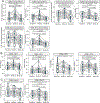Immune changes beyond Th2 pathways during rapid multifood immunotherapy enabled with omalizumab
- PMID: 33782956
- PMCID: PMC8609920
- DOI: 10.1111/all.14833
Immune changes beyond Th2 pathways during rapid multifood immunotherapy enabled with omalizumab
Abstract
Background: Multifood oral immunotherapy (mOIT) with adjunctive anti-IgE (omalizumab, XOLAIR® ) treatment affords safe, effective, and rapid desensitization to multiple foods, although the specific immune mechanisms mediating this desensitization remain to be fully elucidated.
Methods: Participants in our phase 2 mOIT trial (NCT02643862) received omalizumab from baseline to week 16 and mOIT from week 8 to week 36. We compared the immune profile of PBMCs and plasma taken at baseline, week 8, and week 36 using high-dimensional mass cytometry, component-resolved diagnostics, the indirect basophil activation test, and Luminex.
Results: We found (i) decreased frequency of IL-4+ peanut-reactive CD4+ T cells and a marked downregulation of GPR15 expression and CXCR3 frequency among γδ and CD8+ T-cell subsets at week 8 during the initial, omalizumab-alone induction phase; (ii) significant upregulation of the skin-homing receptor CCR4 in peanut-reactive CD4+ T and Th2 effector memory (EM) cells and of cutaneous lymphocyte-associated antigen (CLA) in peanut-reactive CD8+ T and CD8+ EM cells; (iii) downregulation of CD86 expression among antigen-presenting cell subsets; and (iv) reduction in pro-inflammatory cytokines, notably IL-17, at week 36 post-OIT. We also observed significant attenuation of the Th2 phenotype post-OIT, defined by downregulation of IL-4 peanut-reactive T cells and OX40 in Th2EM cells, increased allergen component-specific IgG4/IgE ratio, and decreased allergen-driven activation of indirectly sensitized basophils.
Conclusions: This exploratory study provides novel comprehensive insight into the immune underpinnings of desensitization through omalizumab-facilitated mOIT. Moreover, this study provides encouraging results to support the complex immune changes that can be induced by OIT.
Keywords: IgE; biologics; food allergy; immunotherapy and tolerance induction; immunotherapy clinical; lymphocytes.
© 2021 EAACI and John Wiley and Sons A/S. Published by John Wiley and Sons Ltd.
Figures








References
-
- Koplin JJ, Mills EN, Allen KJ. Epidemiology of food allergy and food-induced anaphylaxis: is there really a Western world epidemic? Curr Opin Allergy Clin Immunol 2015;15:409–416. - PubMed
Publication types
MeSH terms
Substances
Associated data
Grants and funding
- U19 AI104209/AI/NIAID NIH HHS/United States
- R01AI140134-02/NH/NIH HHS/United States
- 5UM2AI130836-04/NH/NIH HHS/United States
- 5T32AI007512/NH/NIH HHS/United States
- T32 AI007512/AI/NIAID NIH HHS/United States
- R01AI119918/NH/NIH HHS/United States
- U01 AI140498/AI/NIAID NIH HHS/United States
- U19AI104209/NH/NIH HHS/United States
- U01 AI140498-03/NH/NIH HHS/United States
- UM2 AI130836/AI/NIAID NIH HHS/United States
- U01 AI147462/AI/NIAID NIH HHS/United States
- R01 AI119918/AI/NIAID NIH HHS/United States
- R01 AI140134/AI/NIAID NIH HHS/United States
LinkOut - more resources
Full Text Sources
Other Literature Sources
Medical
Research Materials

